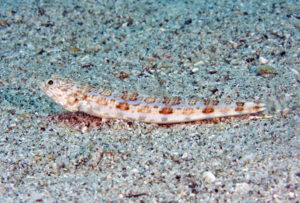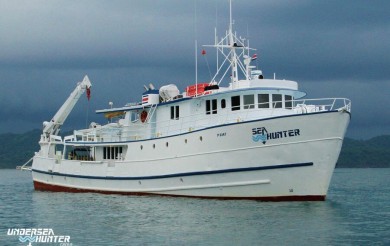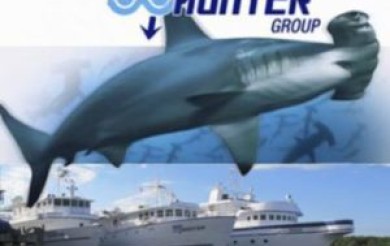Sauro Lizardfish
Sauro Lizardfish (Synodus lacertinus)
Other name: Calico Lizardfish
Max. Length: 20 centimeters
Length at 1st Maturity: 12.9 centimeters
a value:
b value:
Depth Range: 1 – 30 meters (3 – 100 feet)
Frequency: Abundant in the reefs of the Eastern Pacific Ocean
If we speak of diving in Cocos Island, observing sharks is guaranteed to be certain where your dive profile often leads you clinging or hiding in rocks and crevices. While taking refuge to this solid underwater structure, you will observe that there are also small fish thriving in this environment where you will most probably see a Sauro Lizardfish.
Endemic or found only in the reefs of the Eastern Pacific Ocean, you can easily identify this small fish through its relatively short snout where both the eyes and mouth are large. Its body coloration is mottled brown on the upper half of the body while the lower half has a reddish shading. Their dorsal and caudal fin has narrow linings that are colored black.
Look at the Floor, not the Ceiling
If you think lizardfish in general are named after the behavior of their land-based counterparts, then think again. While we often we see land lizards in the ceilings of our house, it is a different case for lizardfish where you need to focus your attention to the floor of the reef where they can be found. And besides, technically, there’s no ceiling in the reef.
The reason behind naming them after lizards is the similarity with their body shape and the way the use them. For example, one of the behaviors lizardfish does is lying in motionless with their pectoral fins spread out which represents a lizards legs.
Now, let’s forget about lizards and focus our attention to lizardfish. When you go diving in Cocos Island, you will notice that a lizardfish is often solitary and not in a group. They may sometime bury themselves in the sand where they can perform the ambush technique for predation where their favorite meal is composed of small fish, crabs and shrimps.
At the end of the day, diving in Cocos Island is not just about finding the big boys like hammerhead sharks but also small resident fish like the Sauro Lizardfish.
Reference
Fishbase: www.fishbase.org
IUCN Redlist of Threatened Species: www.iucnredlist.org
World Register of Marine Species: www.marinespecies.org
You also might like these:
Cocos Island Liveaboard Trips for 2019
Due to high demand of liveaboard trips to Cocos island, as early as this year, we are publishing the 2019 trips for you to choose your preferred schedule and prepare for the ultimate diving adventure of your life. Reserve your seat to Cocos Island as they are selling like hotcakes. Schedule of Liveaboard Trip to […]















